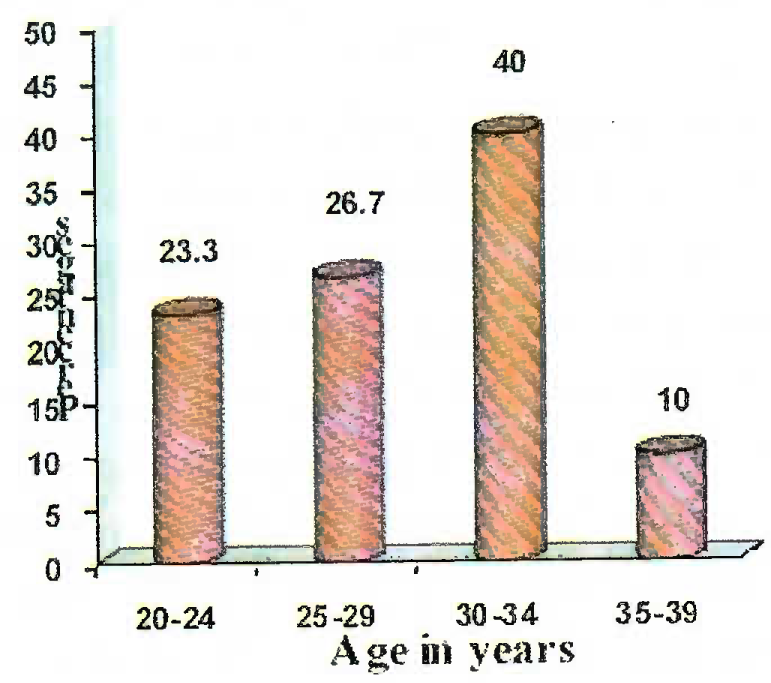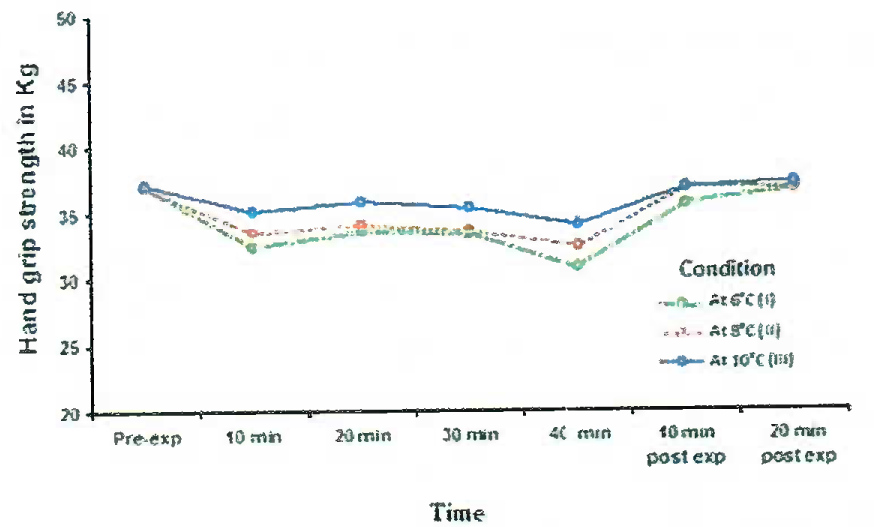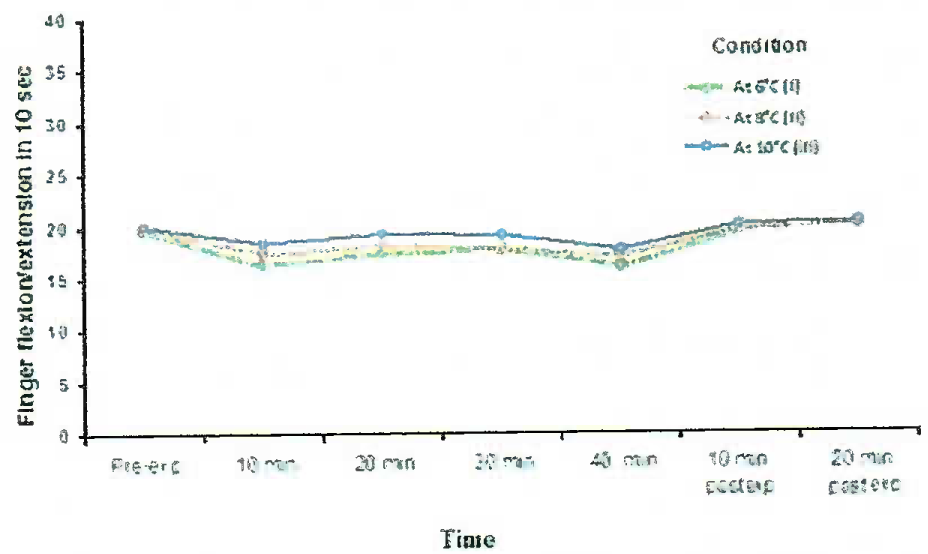Translate this page into:
Decrement in manual arm performance in cold
Abstract
Manual performance is determined by the range of motion of arm, hand and fingers and the possibility to manipulate with hand and fingers. Cold stress is known to adversely affect manual performance. Studies conducted in the past have shown critical threshold value for decrement in the manual dexterity, tactile sensitivity, muscle power and nerve conduction velocity. The present study w as conducted to find out the correlation between decrement in manual arm performance and duration of exposure to cold. The study was conducted in the cold room at IAM, IAF using 30 healthy male volunteers, who were exposed to temperatures of 6,8 and 10 degrees celcius for duration of 40 min. Three manual tasks were performed to measure the following parameters-finger dexterity, hand grip strength, and speed of flexion/extension of fingers. These tasks were performed before exposure, during exposure to cold environment (every 10 min) up to 40 min and then till 20 min post exposure. Simultaneously heart rate, blood pressure, oral temperature and hand skin temperature were also measured. For statistical analysis, Repeated Measure Analysis of Variance (RMANOVA) and Paired t-test were used. Results indicated a significant decrease in the three manual tasks at 6”C, 8’’C and 10”C. However there was an increase in the performance after an initial decrement. Findings of the study show that there is a decrement in manual arm performance with fall in the hand skin temperature even without much change in core temperature and there may be a slight increase in the manual performance because of increased arousal.
Keywords
Cold stress
manual dexterity
tactile sensitivity
handgrip strength
Indian Air Force and Army Aviation Corps are routinely deployed in extreme cold climate areas where the fighter aircrafts, transport aircrafts and helicopters are engaged in different roles like combat, logistic support, transport of troops and casualty air evacuation. The operations are earned out from bases which are snow bound throughout the year with subzero temperatures. This extreme cold exposure may affect manual performance and work efficiency of aviators, ground technicians and other support personnel. The decline in performance is due to cooling of extremities, fall in core or central temperature and physiological factors that precede or follow the exposure to cold. In air or water, the first tissue to be-affected on exposure to cold is the skin. It is the extremities (hands and feet) that are most affected owing to their high surface area/mass ratio [1] and the fact that their major source of heat-the blood flow, is restricted by vasoconstriction [2]. After the skin, the next structures to cool are the superficial nerves and muscles. Cooling of the hands has negative effect on manual performance [3, 4, 5]. Speed of movement, dexterity, strength and mechanical efficiency are reduced with cooling. Extremity cooling causes a progressive decline in the performance of manual tasks, especially those involving fine finger manipulation and coordination. This is especially true for ground crews who are not only exposed to cold air but also use their hands to perform tasks, where heat loss can occur when touching metal tools [6]. The effects of cold on cutaneous sensitivity and manual dexterity cause deterioration in the work efficiency of technicians who operate switches, push buttons, knobs, keys, screws, nuts and bolts. Aircrew is exposed to severe cold during certain open-door and open-hatch operations, when the hand skin temperature is lowered. Also in cases of ejection, there may be a loss of gloves or some part of the protective clothing. The protection from the environment afforded by the aircraft is lost when pilots are forced to land or ditch [6]. Once on the ground or in the water, flight crew are fully exposed and a large part of survival depends on meeting environmental challenges. In such situations, man’s ability to perform manual tasks is vital for survival, as well as for activation of self rescue apparatus, operation of survival gear, maintaining orientation and affecting rescue by signaling and communication. A loss of these abilities will certainly affect the chances of a successful rescue [7],
Materials and methods
After taking an informed consent, 30 healthy male volunteers of age 20-40 years from Institute of Aerospace Medicine were used as subjects in the study. The experiment was conducted in the months of Sep-Dec over 03 days for each subject. Subjects were advised to refrain from consuming alcohol and to adhere to a normal diet and have good sleep on the day prior to the study. Experiment was conducted in the morning hours at Department of Space and Environmental Physiology, IAM. The subjects were dressed in winter uniform (with jersey pullover) with sleeves rolled up to mid forearm. They were asked to perform the following tests of physical performance before and after the exposure, and every 10 minutes during exposure to a temperature of 6°C, 8°C and 10°C in the cold room on different days:
Speed of finger flexion and extension
This test requires dynamic contractions of the forearm flexor muscles. Subjects were asked to close and open the dominant fist as quickly as possible. Result was reported as number of flexion and extension in 10 seconds.
Hand grip strength
This test requires static contraction of the forearm flexor muscles. Baseline® Hand grip dynamometer was used to measure isometric hand grip strength. Subject held the dynamometer in the dominant hand at arm’s length and performed one maximal contraction.
Finger dexterity test
The pin and board test was used for checking finger dexterity. The board was made on the lines of O’Connor Tweezer Dexterity Test which is a validated test. This test mainly utilizes the small muscles of hands and fingers. The subject was asked to pick up pins from slots provided on one end of a board with the help of a forceps and place them on slots on the other end of the board. The slots for placing the pins on the board were equidistant. The test was scored as total number of pins placed on the board in one minute.
The baseline recording of oral temperature, mean hand skin temperature, heart rate, blood pressure and the above mentioned tests was done prior to cold exposure and every 10 minutes during cold exposure. The subjects were exposed to cold for 40 minutes or till such time they could tolerate cold. The exposure was terminated in case of any discomfort to the subject. All the vital parameters were recorded and the physical tests as mentioned were performed every 10 minutes during recovery, after the subject was taken out of the cold room. The readings were recorded till 20 min after the exposure was terminated.
The desired cold environment (6°C, 8°C, and 10°C) was simulated in the cold room using 2 microprocessor controlled air conditioners. Agilent M 3046 A Monitor was used for measuring heart rate and blood pressure. Body temperatures were recorded using a sixteen-channel Intelligent Satellite Unit Temperature Recorder (Century Systems, Bangalore), which is a micro-controller based multichannel data acquisition unit. This was used to measure the oral temperature and the hand skin temperature. The skin temperature measuring probes were Resistance Temperature Detector Type PT-100 sensors (Century Systems Bangalore).
Statistical analysis
The Statistical software namely SPSS 15.0, Stata 8.0, MedCalc 9.0.1 and Systat 11.0 were used for the analysis of the data. For statistical analysis, Repeated Measure Analysis of Variance (RMANOVA) was used to find the significance of study parameters between the three different environmental conditions and Paired t-test was used to find the significance of study events from pre-exposure independently. Significance was assessed at 5% level of significance.
Results
The age distribution of the subjects is shown in Figure 1. The mean age of the subjects was 28.6 ±5.68 years.
There was a decrease in the heart rate and increase in the blood pressure with cold exposure. The decrease in core temperature at 40 minutes of exposure was 0.88°C at 6°C, 0.72°C at 8°C and 0.62°C at 10°C. At 40 min of exposure, the hand skin temperature reduced from 32.86°C to 22.67°C at 6°C, 32.87°C to 24.78°C at 8°C and from 33.07°C to 26.07°C at 10°C.

- Age distribution
There was significant decrease in the hand grip strength during exposure to all the three conditions, as shown in Figure 2. In all the three conditions the values obtained at 20 min of exposure were slightly more as compared to the values at 10 min. Maximum decrement was seen at 40 min of exposure. The hand grip strength decreased by 16.44% at 6°C, 12.45% at 8°C and 8.18% at 10°C after 40 min of exposure to cold, as compared to the pre-exposure valuse.

- Hand grip strength in cold
The effect of cold exposure on frequency of finger flexion/ extension and dexterity are as shown in Figure 3 and Figure 4 respectively. The effects of cold on these parameters were similar to those observed on hand grip strength.

- Finger flexion/ extension in cold
There was a decrease in frequency of flexion/ extension of fingers by 18.47% at 6°C, 14.48% at 8°C and 11.48% at 10°C after 40 min of exposure, as compared to the pre-exposure baseline value.
The manual dexterity decreased by 25% at 6°C, 19.93% at 8°C and 16.37% at 10°C after 40 minutes of exposure. Post exposure there was an increase in all the manual task parameters.

- Dexterity in cold
A temporary increase was however observed in the three parameters at 10 minutes as compared to the 20 minute value, which again decreased as the exposure was continued.
Discussion
The study shows that there is significant decrease in the three manual tasks, when subjects were exposed to three low temperature conditions i.e. at 6°C, 8°C and 10°C, as compared to the pre exposure measurements at room temperature. There is a continuous relationship between finger skin temperature and tactile sensitivity and manual dexterity over a range of temperature rather than a critical threshold and there was a slight increase in the performance after an initial decrease.
The decrement seen at 6°C was more as compared to that seen in 8°C and 10°C condition because the fall in hand skin temperature was more at 40 min of exposure at 6°C compared to the other two temperatures. The decrements were observed with a little change in core temperature, however the change in hand skin temperature was appreciable. This observation shows that manual dexterity is dependent more on the hand skin temperature.
The reduction in manual arm performance observed in the study is the resultant of a number of concomitant and complex changes. The effect of muscle performance on manual arm performance can act through changes in muscle power, contraction speed or muscle endurance. Cooling may interfere with joint movements causing stiffness of fingers due to increased viscosity of synovial fluid and tissues of the hand [3, 8]. Stiffness could also be result of an increase in the viscosity of the long flexors and extensors of the fingers and/or their tendon sheaths [9]. In addition, cooling could decrease the efficiency of activating muscles through a decrease in metabolic rate, ATP utilization, enzyme activity, slowed calcium and acetylcholine release, delayed cross bridge formation and decreased power production [10, 11]. Cooling decreases excitability of nerve membranes and nerve conduction velocity [12].
Earlier studies have shown that there is a decrement in manual dexterity at local skin temperature of 12-16°C [13]. Critical threshold theory has been suggested for degradation in tactile sensitivity (12-16° C) and manual dexterity (8° C) [14]. Below a muscle temperature of 27°C, the contractile force and rate of force application is reduced and maximum power output falls [15].
In the present study, the fall in the core temperature was not much as compared to the previous studies, but the fall in hand skin temperature was sufficient to cause a decrement of the motor speed. This finding can be supported by the fact that the actual temperature at which different grades of impairment occur varies with some factors such as type of task, duration and condition of cold exposure as well as individual factors. There was a slight increase in the manual dexterity, handgrip strength and frequency of finger flexion/extension observed at 20 min of exposure as compared to that at 10 min of exposure. This finding may be due to involvement of multiple factors in addition to the above mentioned mechanisms. While it is suggested that the cold environment causes distraction resulting in inattentiveness to the task at hand, Enander suggests that arousal due to mild cold exposure could account for improved performance that sometimes occur [16]. It can also be explained by the distraction arousal theory proposed by Teichner, Arees, and Reilly (1963) [17]. They contended that stressors have two primary mechanisms for negatively affecting performance: They either distract the operator, drawing attention away from the primary task or they increase the operator’s level of arousal past optimal levels. An advantage of the arousal theory is its ability to explain the improvement in performance under environmental stress. One possible explanation could be that the subjects were exposed to a cold temperature suddenly from a comfortable temperature which caused a distracting effect and so the first reading after exposure was less, but subsequently the subjects got used to this temperature thus explaining the increase in the values obtained at 20 min of exposure. When the exposure was continued, there was a continuous fall in the hand skin temperature, so the manual arm performance deteriorated and the values measured at 30 min and 40 min of exposure were less as compared to the 20 min values. Other factors involved may be the changes in the level of motivation, which occurred first due to sudden exposure of the subjects to low ambient temperature cold and then after spending some time in the cold environment.
Conclusion
The results show that decrement in manual arm performance was observed even in the presence of a lesser decrease in core temperature, when the hand skin temperature was decreasing with increasing duration of exposure. It can be concluded from the results that decrease in hand skin temperature has the major contribution in causing a decrement in manual arm performance with cold exposure. Also, there can be a temporary improvement in the performance because of changes in the arousal and motivation levels. Decrease in manual performance in extreme cold environments, coupled with the effect of cold on mechanical controls, may require the ergonomic redesign of specialized tools to increase leverage, specialized pre-training to increase hand strength, or the redesign of controls or tasks.
Conflict of Interest : None.
References
- Body temperature, temperature regulation and fever In: Textbook of Medical Physiology (11 ed). Philadelphia: WB Saunders; 2006. p. :889-900. In:
- [Google Scholar]
- Thermal stress In: Fundamentals of Aerospace Medicine. Ed. Wilkins; 2006. p. :206-20. In:
- [Google Scholar]
- Decrement in manual arm performance during whole body cooling. Aviat Space Environ Med. 1992;63:1077-81.
- [Google Scholar]
- The relation between joint stiffness ypon exposure to cold and the characteristics of synovial fluid. Can J Med Sci. 1952;30:367-77.
- [Google Scholar]
- Isolated effects of peripheral arm and central body cooling on arm performance. Aviat Space Environ Med. 1995;66:968-75.
- [Google Scholar]
- Effect of temperature on the contractile properties and muscle power of triceps surae in humans. J Appi Physiol. 1983;55:191-5.
- [Google Scholar]
- Muscle temperature of mammals: cooling impairs most functional properties. 1990;28:223-65.
- Thermal stress and survival In: Ernsting’s Aviation Medicine (4 Ed). London: Butterworths; 2006. p. :213-29. In:
- [Google Scholar]
- Effects of moderate cold on performance of psychomotor and cognitive tasks. Ergonomics. 1987;30(10):1431-45.
- [Google Scholar]






